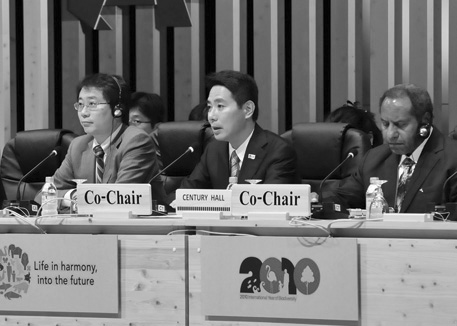Japan's Official Development Assistance White Paper 2010
3. Addressing Global Issues
(1) Environment and Climate Change Issues
International discussions on environmental issues began in the 1970s. Through discussions at the United Nations Conference on Environment and Development (UNCED, also called the Earth Summit) in 1992 and at the World Summit on Sustainable Development (WSSD) of 2002, their importance has been increasingly recognized. Constructive discussion also took place on environment and climate change at the G8 Hokkaido Toyako Summit held in July 2008 that took up the issues as one of the major themes. The international community as a whole must address environmental issues for the prosperity of humankind in the future.

Minister for Foreign Affairs Maehara serving as co-chair at the Aichi-Nagoya Ministerial Meeting of the REDD+ Partnership
<Japan’s Efforts>
In the area of pollution control, Japan has accumulated a great amount of experience and technology and made use of such experience and technology for the pollution issues in developing countries. Particularly, Japan supports pollution control in urban areas and improving the living environment (air pollution, water contamination, waste management, etc.), mainly in the Asian countries achieving rapid economic growth.
Climate change is an urgent matter for mankind that threatens human security across the borders. As such, it is essential for the international community, including both developed and developing countries, to work together to enhance measures on this issue. In September 2009, Prime Minister Yukio Hatoyama announced at the United Nations (UN) Summit on Climate Change that Japan would aim to reduce its emissions by 25% by 2020, if compared to the 1990 level, premised on the establishment of a fair and effective international framework by all major economies and agreement on their ambitious targets.
At the 15th session of the Conference of Parties to the United Nations Framework Convention on Climate Change (COP15) held in December 2009 in Copenhagen, Denmark, the Copenhagen Accord was formulated as a result of the discussions and negotiations which took place at the summit level and the COP agreed to take heed of the accord. Japan announced that it would provide assistance to developing countries which are taking active emissions reduction and other climate change measures or those which are vulnerable to the negative impacts of climate change, on the scale of ¥1,750 billion (about US$15 billion), including public and private financing, over about a three-year period until the end of 2012 (Note 22). This announcement gave a boost to the COP15 negotiations.
Furthermore, regarding the discussions of Reducing Emissions from Deforestation and Forest Degradation in Developing Countries (REDD+ (Note 23)), taking into account the strides made at COP15, participants agreed in May 2010 to establish the REDD+ Partnership, with a view to strengthening partnership and coordination among the REDD+ actions of the international community. Japan, along with Papupa New Guinea, was selected to serve as co-chair of the Partnership until the end of 2010, and in October, hosted the Aichi-Nagoya Ministerial Meeting of the REDD+ Partnership. Japan has been actively supporting the efforts of REDD+. Japan has pledged US$500 million in short-term assistance until 2012, and has already implemented approximately US$200 million of this assistance (as of July 2010).
●Indonesia: Second Climate Change Program Loan
If deforestation, destruction of peatlands, and other factors are included, Indonesia is the world’s fourth largest emitter of greenhouse gasses after China, the U.S., and Brazil (Note 24). Indonesia is also likely to face greater climate change risks as global warming worsens. In this context, Japan provided ODA loans of approximately ¥7.4 billion (including approximately ¥9.4 billion in emergency financial assistance) to support the climate change efforts of the Government of Indonesia. This assistance is expected to: (1) contribute to mitigating global warming through the absorption and emissions reduction of greenhouse gases; (2) improve Indonesia’s capacity to adapt to the negative impacts of climate change; and (3) promote responses to cross-cutting issues related to climate change.
Notes:
(22) Public financing accounts for approximately ¥1,300 billion (approximately US$11 billion).
(23) REDD refers to a concept in relation to reducing greenhouse gas emissions from deforestation and forest degradation in developing countries. The concept establishes reference levels of future emissions based on past trends, etc., and uses financial and other incentives to achieve emissions reductions below the reference levels. When it includes forest preservation, sustainable forest management, and increase of carbon accumulation in the forest, it is referred to as REDD+.
(24) World Resource Institute Climate Analysis Indicators Tool (WRI CAIT), Sum of ”Total in 2007” and ”LUCF in 2005” (2007).
